Krugman_PPT_ch06 2010 part 1-2
- 格式:pdf
- 大小:326.53 KB
- 文档页数:21

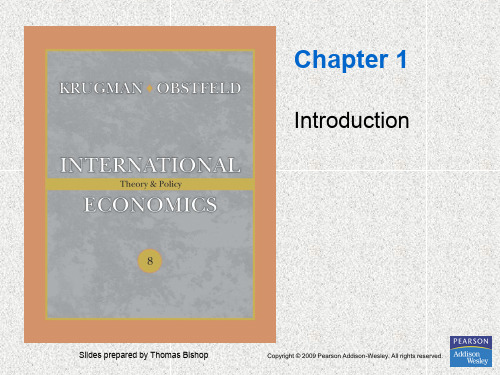
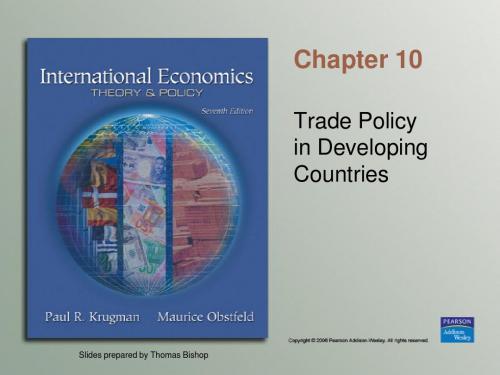
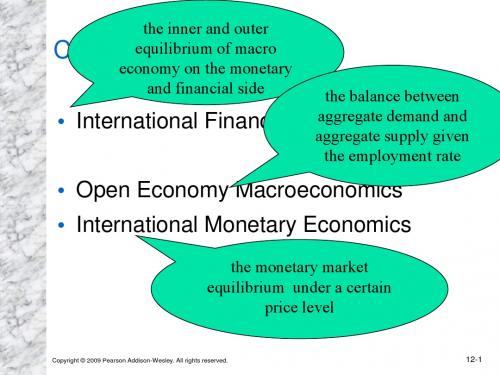
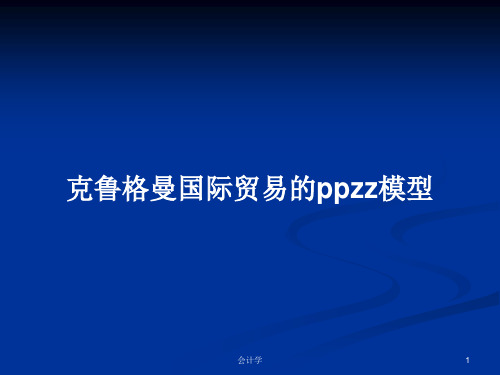
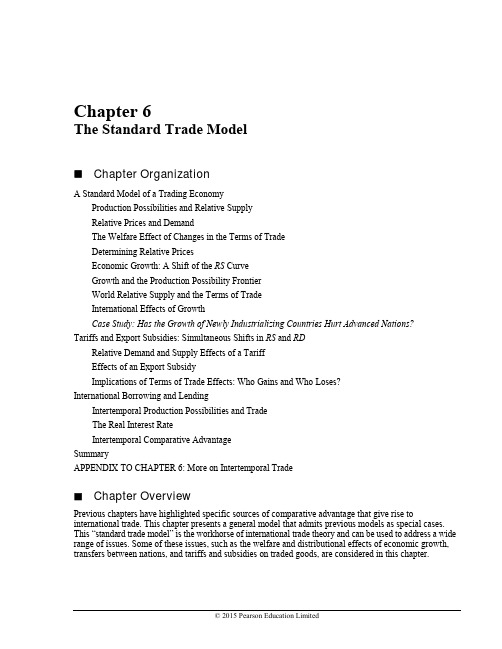
Chapter 6The Standard Trade Model⏹Chapter OrganizationA Standard Model of a Trading EconomyProduction Possibilities and Relative SupplyRelative Prices and DemandThe Welfare Effect of Changes in the Terms of TradeDetermining Relative PricesEconomic Growth: A Shift of the RS CurveGrowth and the Production Possibility FrontierWorld Relative Supply and the Terms of TradeInternational Effects of GrowthCase Study: Has the Growth of Newly Industrializing Countries Hurt Advanced Nations?Tariffs and Export Subsidies: Simultaneous Shifts in RS and RDRelative Demand and Supply Effects of a TariffEffects of an Export SubsidyImplications of Terms of Trade Effects: Who Gains and Who Loses?International Borrowing and LendingIntertemporal Production Possibilities and TradeThe Real Interest RateIntertemporal Comparative AdvantageSummaryAPPENDIX TO CHAPTER 6: More on Intertemporal Trade⏹Chapter OverviewPrevious chapters have highlighted specific sources of comparative advantage that give rise to international trade. This chapter presents a general model that admits previous models as special cases. This “standard trade model” is the workhorse of international trade theory and can be used to address a wide range of issues. Some of these issues, such as the welfare and distributional effects of economic growth, transfers between nations, and tariffs and subsidies on traded goods, are considered in this chapter.28 Krugman/Obstfeld/Melitz •International Economics: Theory & Policy, Tenth EditionThe standard trade model is based upon four relationships. First, an economy will produce at the point where the production possibilities curve is tangent to the relative price line (called the isovalue line). Second, indifference curves describe the tastes of an economy, and the consumption point for that economy is found at the tangency of the budget line and the highest indifference curve. These two relationships yield the familiar general equilibrium trade diagram for a small economy (one that takes as given the terms of trade), where the consumption point and production point are the tangencies of the isovalue line with the highest indifference curve and the production possibilities frontier, respectively.You may want to work with this standard diagram to demonstrate a number of basic points. First, an autarkic economy must produce what it consumes, which determines the equilibrium price ratio; and second, opening an economy to trade shifts the price ratio line and unambiguously increases welfare. Third, an improvement in the terms of trade (ratio of export prices to import prices) increases welfare in the economy. Fourth, it is straightforward to move from a small country analysis to a two-country analysis by introducing a structure of world relative demand and supply curves, which determine relative prices.These relationships can be used in conjunction with the Rybczynski and the Stolper-Samuelson theorems from the previous chapter to address a range of issues. For example, you can consider whether the dramatic economic growth of China has helped or hurt the United States as a whole and also identify the classes of individuals within the United States who have been hurt by China’s particular growth biases. In teaching these points, it might be interesting and useful to relate them to current events. For example, you can lead a class discussion on the implications for the United States of the provision of forms of technical and economic assistance to the emerging economies around the world or the ways in which a world recession can lead to a fall in demand for U.S. exports.The example provided in the text considers the popular arguments in the media that growth in China hurts the United States. The analysis presented in this chapter demonstrates that the bias of growth is important in determining welfare effects rather than the country in which growth occurs. The existence of biased growth and the possibility of immiserizing growth are discussed. The Relative Supply (RS) and Relative Demand (RD) curves illustrate the effect of biased growth on the terms of trade. The new termsof trade line can be used with the general equilibrium analysis to find the welfare effects of growth. A general principle that emerges is that a country that experiences export-biased growth will have a deterioration in its terms of trade, while a country that experiences import-biased growth has an improvement in its terms of trade. A case study argues that this is really an empirical question, and the evidence suggests that the rapid growth of countries like China has not led to a significant deterioration of the U.S. terms of trade nor has it drastically improved China’s terms of trade.The second area to which the standard trade model is applied is the effects of tariffs and export subsidies on welfare and terms of trade. The analysis proceeds by recognizing that tariffs or subsidies shift both the relative supply and relative demand curves. A tariff on imports improves the terms of trade, expressed in external prices, while a subsidy on exports worsens terms of trade. The size of the effect depends upon the size of the country in the world. Tariffs and subsidies also impose distortionary costs upon the economy. Thus, if a country is large enough, there may be an optimum, nonzero tariff. Export subsidies, however, only impose costs upon an economy. Internationally, tariffs aid import-competing sectors and hurt export sectors, while subsidies have the opposite effect.The chapter then closes with a discussion of international borrowing and lending. The standard trade model is adapted to trade in consumption across time. The relative price of future consumption is defined as 1/(1 r), where r is the real interest rate. Countries with relatively high real interest rates (newly industrializing countries with high investment returns for example) will be biased toward future consumption and will effectively “export” future consumption by borrowing from established developed countries with relatively lower real interest rates.Chapter 6 The Standard Trade Model 29Answers to Textbook Problems1.If the relative price of palm oil increases in relation to the price of lubricants, this would increase theproduction of palm oil, because Indonesia exports palm oil. Similarly, an increase in relative price of lubricants leads to a shift along the indifference curve, towards lubricants and away from palm oil for Indonesia. This is because Palm oil is relatively expensive, hence reducing palm oil consumption in Indonesia.Expensive palm oil increases the relative income of Indonesia. The income effect would induce more for the consumption of palm oil whereas the substitution effect acts to make the economy consume less of palm oil and more of lubricants. However, if the income effect outweighs the substitution effect, then the consumption of palm oil would increase in Indonesia.2.In panel a, the re duction of Norway’s production possibilities away from fish cause the production of fish relative to automobiles to fall. Thus, despite the higher relative price of fish exports, Norway moves down to a lower indifference curve representing a drop in welfare.In panel b, the increase in the relative price of fish shifts causes Norway’s relative production of fish to rise (despite the reduction in fish productivity). Thus, the increase in the relative price of fish exports allows Norway to move to a higher indifference curve and higher welfare.3. The terms of trade of the home country would worsen. This is because a strong biased productiontowards cloth would increase the home country’s supply of cloth and shifts the supply curve to the right. At the same time, the production of wheat would decline relative to the production of cloth. An increased supply of cloth would reduce the price at the domestic and at the international market. The reduction in international price of cloth would worsen the terms of trade of the home country as the home country exports. On the other hand, if the home country’s production grows in favor of wheat, the terms of trade would improve in favor of the home country. This is because wheat is imported by the home country.30 Krugman/Obstfeld/Melitz •International Economics: Theory & Policy, Tenth Edition4. The difference from the standard diagram is that the indifference curves are right angles rather thansmooth curves. Here, a terms of trade increase enables an economy to move to a higher indifference curve. The income expansion path for this economy is a ray from the origin. A terms of tradeimprovement moves the consumption point further out along the ray.5. The terms of trade for Japan, a manufactures (M) exporter and a raw materials (R) importer, is the worldrelative price of manufactures in terms of raw materials (p M/p R). The terms of trade change can be determined by the shifts in the world relative supply and demand (manufactures relative to raw materials) curves. Note that in the following answers, world relative supply (RS) and relative demand (RD) are always M relative to R. We consider all countries to be large, such that changes affect the worldrelative price.a. An oil supply disruption from the Middle East decreases the supply of raw materials, whichincreases the world relative supply of manufactures to raw materials. The world relative supplycurve shifts out, decreasing the world relative price of manufactured goods and deterioratingJapan’s terms of trade.b. Korea’s increased automobile production increases the supply of manufactures, which in creasesthe world RS. The world relative supply curve shifts out, decreasing the world relative price ofmanufactured goods and deteriorating Japan’s terms of trade.c. U.S. development of a substitute for fossil fuel decreases the demand for raw materials. Thisincreases world RD, and the world relative demand curve shifts out, increasing the world relative price of manufactured goods and improving Japan’s terms of trade. This occurs even if no fusion reactors are installed in Japan because world demand for raw materials falls.d. A harvest failure in Russia decreases the supply of raw materials, which increases the world RS.The world relative supply curve shifts out. Also, Russia’s demand for manufactures decreases,which reduces world demand so that the world relative demand curve shifts in. These forcesdecrease the world relative price of manufactured goods and deteriorate Japan’s terms of trade.e. A reduction in Japan’s tariff on raw materials will raise its internal relative price of manufactures(p M/p R). This price change will increase Japan’s RS and decrease Japan’s RD, which increases the world RS and decreases the world RD (i.e., world RS shifts out and world RD shifts in). The worldrelative price of manufactures declines, and Japan’s terms of tr ade deteriorate.6. The declining price of services relative to manufactured goods shifts the isovalue line clockwise sothat relatively fewer services and more manufactured goods are produced in the United States, thus reducing U.S. welfare.Chapter 6 The Standard Trade Model 31 7. These results acknowledge the biased growth that occurs when there is an increase in one factor ofproduction. An increase in the capital stock of either country favors production of good X, while an increase in the labor supply favors production of good Y. Also, recognize the Heckscher-Ohlin result that an economy will export that good that uses intensively the factor which that economy has in relative abundance. Country A exports good X to country B and imports good Y from country B. The possibility of immiserizing growth makes the welfare effects of the terms of trade improvement due to export-biased growth ambiguous. Import-biased growth unambiguously improves welfare for the growing country.a. The relative price of good X falls, causing country A’s terms of trade to worsen. A’s welfare mayincrease or, less likely, decrease, and B’s welfare increases.b. The relative price of good Y rises, causing A’s terms of trade to improve. A’s welfare increases,and B’s welfare decreases.c. The relative price of good X falls, causing country B’s terms of trade to improve. B’s welfareincreases, and A’s welfare decreases (they earn less for the same quantity of exports).d. The relative price of good X rises, causing country B’s terms of trade to worsen. B’s welfare mayi ncrease or, less likely, decrease, and A’s welfare increases.8. Immiserizing growth occurs when the welfare deteriorating effects of a worsening in an economy’sterms of trade swamp the welfare improving effects of growth. For this to occur, an economy must undergo very biased growth, and the economy must be a large enough actor in the world economy such that its actions spill over to adversely alter the terms of trade to a large degree. This combination of events is unlikely to occur in practice.9. India opening its markets to world trade should be good for the United States if the change reducesthe relative price of goods that China sends to the United States and hence increases the relative price of goods that the United States exports. Obviously, any sector in the United States hurt by trade with China would be hurt again by India, but on net, the United States wins. Note that here we are making different assumptions about what India produces and what is tradable than we are in Question 6. Here we are assuming India exports products that the United States currently imports and China currently exports. China will lose by having the relative price of its export good driven down by the increased production in India.10. An import tariff makes the imported goods more expensive in the domestic market as compared tothe world market. In a two commodity system e.g. food and cloth, an imposition of import tariff on cloth makes the cloth more expensive for people in the domestic market. Eventually, the internal price of food is cheaper than the relative price in the external market. This pushes the domesticproducers to produce cloth as the relative price is higher. The home consumers shift theirconsumption from cloth to food. Hence, the relative supply of food will fall and the relative demand will increase. With an increase in the world’s relative price for food the homes terms of trade also increases.Similarly, an export subsidy on food makes the opposite effect on the relative supply and demand than the import tariff on cloth. The effect is that the relative supply of food rises while the relative demand for the world declines. Hence, this reduces the home’s terms of trade as the relative price of food falls in the world market.32 Krugman/Obstfeld/Melitz •International Economics: Theory & Policy, Tenth EditionThe parties emphasize on the reduction of tariff to increase its trade with the partner country under the free trade agreements. When a tariff is reduced by both the partner countries, it increases the trade volume between the two countries. The reduction of tariff and free flow of commodities between the partner countries reduces the market price of the commodity and increases the purchasing power of the consumers in both countries. The agreement on the reduction of tariff is bilateral, meaning both countries agree to reduce the tariff, which ultimately increases the terms of trade for both.11. When a country borrows for the present consumption, it is liable to make the payment in future bysacrificing its future consumption. This means, in future the country has to return the principalborrowing amount with some interest rate. If a country borrows 1 unit at present, it has to return (1+ r) times in future, where r is the real interest rate. Hence, the relative price of future consumption is1/(1+r). This shows there is an inverse relation between the interest rate and the relative price offuture consumption. Higher the real interest rate, lower will be the relative price of futureconsumption and vice-versa.12. Comparative advantage in international borrowing and lending is driven by the relative price of futureconsumption and, more specifically, the real interest rate. As the real interest rate rises, the relative price of future consumption 1/(1 r) falls. Effectively, a country with a high real interest rate is one that has high returns on investment. Such a country will prefer to borrow today and take advantage of the high return on investment and enjoy the fruits of current investment with high returns in the future.a. Countries like Argentina and Canada should have high real interest rates as there are largeinvestment opportunities that have yet to be exploited. These countries will have a low price offuture consumption and will be biased toward exporting future consumption, preferring toborrow today.b. Countries like the United Kingdom in the 19th century or the United States today will haverelatively lower real interest rates as they already have a high level of capital and limited returnson new investments. As a result, the relative price of future consumption is high, and they will be biased toward exporting present consumption, preferring to lend today.c. The discovery of large oil reserves that do not require a significant investment to extract will causereal interest rates in Saudi Arabia to fall (large increase in wealth). This will cause the relativeprice of future consumption to rise, making it more likely that Saudi Arabia will have a PPFbiased toward exporting present consumption. Saudi Arabia will increase their current lending as a result of these oil discoveries.d. Oil discovered in Norway that requires a significant investment to extract will have the oppositeeffect as in answer c. This oil cannot turn into wealth until a significant investment is made, soreal interest rates in Norway will rise with this increased demand for investment funds. Higher real interest rates drive the relative price of future consumption down. As a result, Norway will bemore likely to export future consumption, borrowing today.e. High levels of productivity in South Korea imply that South Korean real interest rates are highgiven the lucrative investment opportunities in the country. As in answer d, higher real interestrates should drive the relative price of future consumption down and bias South Korea’sintertemporal PPF toward exporting future consumption.。